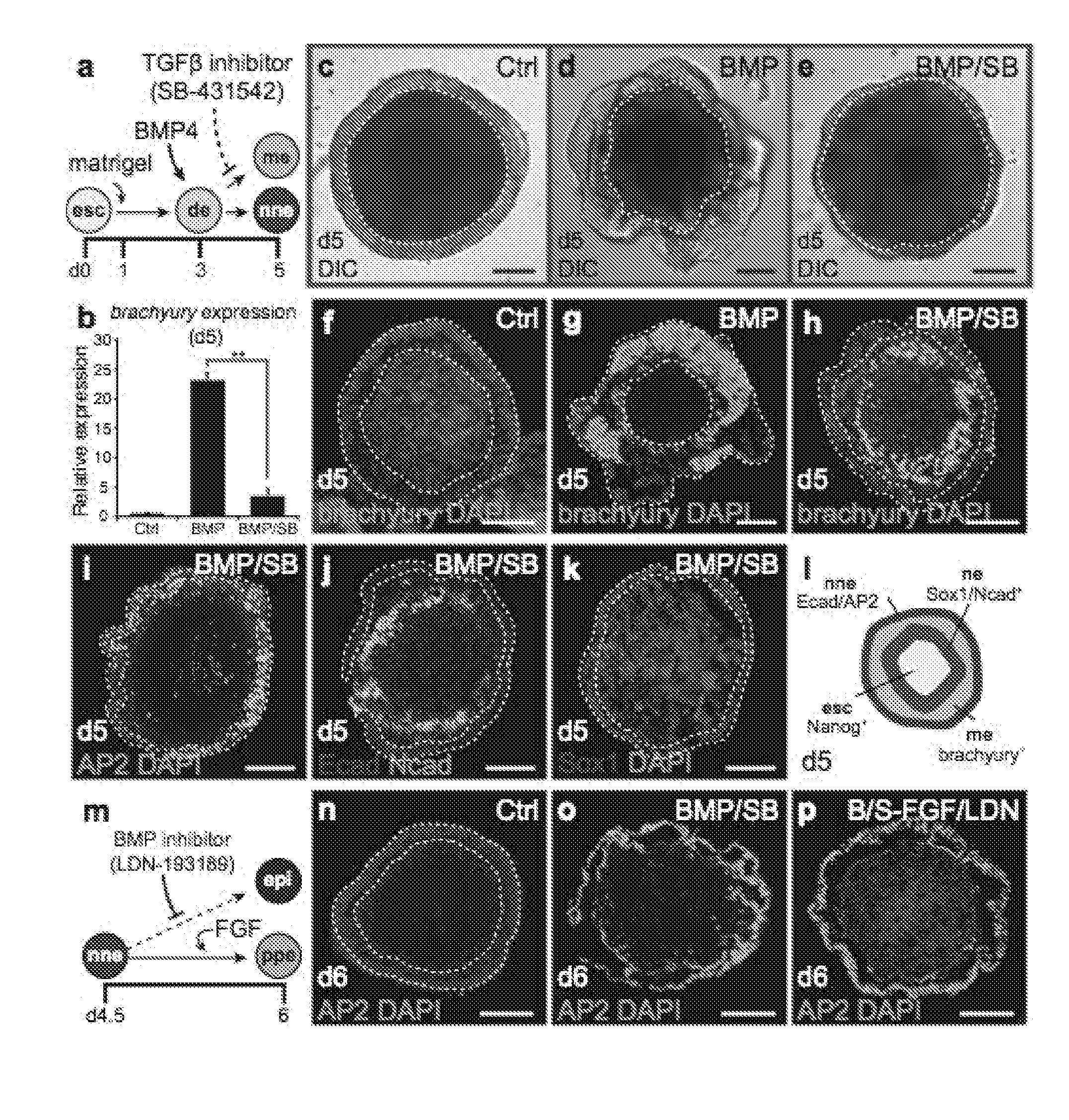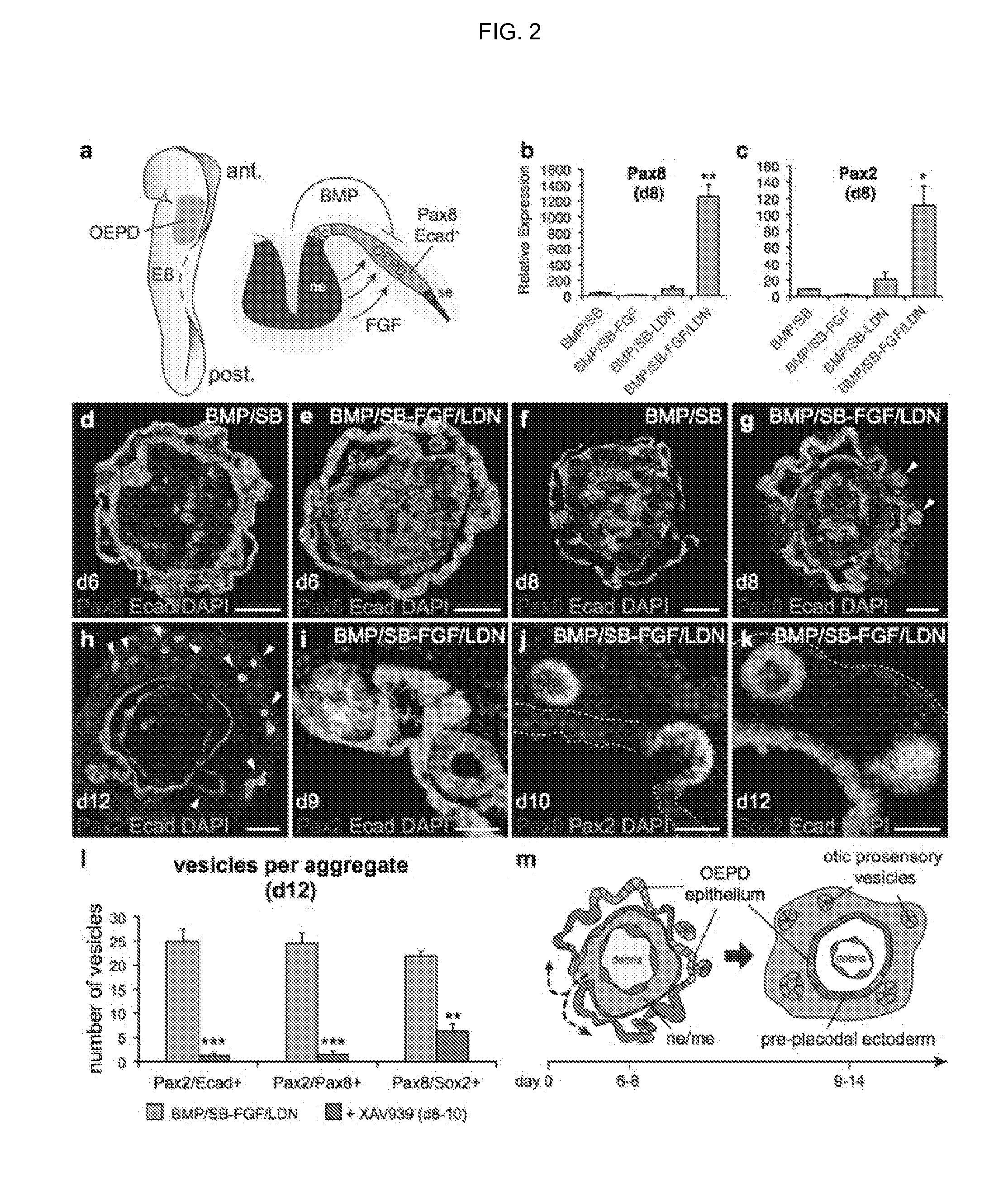Methods for generating the inner ear and other cranial placode-derived tissues using pluripotent stem cells
a technology of cranial placode and stem cells, which is applied in the field of generating inner ear and other cranial placode-derived tissues using pluripotent stem cells, can solve the problems of ineffective cochlear implantation in nearly 15% of snhl cases, no known treatment address the underlying cause of snhl, and a significant challenge in generating inner ear cells from pluripotent cells
- Summary
- Abstract
- Description
- Claims
- Application Information
AI Technical Summary
Benefits of technology
Problems solved by technology
Method used
Image
Examples
example 1
Generation of Pre-Placodal Ectoderm from mES Cells
[0133]Signaling Molecules and Recombinant Proteins.
[0134]The following small molecules and recombinant proteins were used: recombinant human BMP4 (10 ng / mL; Stemgent), human FGF2 (25 ng / mL; Peprotech), XAV939 (1 μM; Santa Cruz), SU5402 (10 μM; BioVision), SB-431542 (1 μM; Tocris Bioscience), and LDN-193189 (100 nM; Stemgent). Notably, we have obtained comparable results using concentrations of up to 1 μM LDN-193189.
[0135]Quantitative PCR.
[0136]RNA was isolated using the RNeasy Minikit (Qiagen) and treated with TURBO DNase (Ambion). Single-stranded cDNA was synthesized using Omniscript reverse transcriptase (Qiagen) and Oligo-dT primers. All amplicons had standardized sizes of 100-110 bps. cDNA samples were amplified on an ABI PRISM 7900HT Sequence Detection System (Applied Biosystems) using the SYBR Green PCR Master Mix (Applied Biosystems). For each PCR reaction, a mixture containing cDNA template (5 ng), Master Mix, and forward and...
example 2
Differentiation of Pre-Placodal Ectoderm into Otic Placode
[0161]In vertebrates, the otic placode is derived from a posterior pre-placodal region known as the otic-epibranchial placode domain (OEPD; FIG. 2a). The otic placode is demarcated from other developing placodes by expression of the transcription factors Pax2 / 8 (see FIG. 10 for the in vivo situation)22. Because the induction of the OEPD requires FGF signaling and the otic placode epithelium thickens, invaginates and forms the otic vesicle (for review see ref 10), we examined whether the vesicle forming-epithelia of BMP / SB-FGF / LDN aggregates were representative of the primordial inner ear. Our qPCR analysis revealed that Pax2 and Pax8 were significantly upregulated in BMP / SB-FGF / LDN samples compared to other conditions (FIG. 2b, c). By day 6, we observed Pax8+ cells distributed in placode-like patches throughout the outer Ecad+ epithelium of only BMP / SB-FGF / LDN aggregates (FIG. 2d, e). Notably, we also observed a population of...
example 3
Wnt and Shh Signaling Activation can Increase the Number of the Inner Ear Cells Derived from Preplacodal Ectoderm
[0167]In our previous study we found that inhibition of Wnt signaling using a small molecule inhibitor, XAV939 (on days 8-10), blocked the generation of otic vesicles following BMP / SB-FGF / LDN treatment. This demonstrated that Wnt signaling is critical for vesicle formation in vitro mimicking in vivo otic vesicle formation. We tested whether Wnt activation could enhance the generation of otic vesicles in vitro. BMP / SB-FGF / LDN treated aggregates were transferred to a floating culture in N2 Medium containing the Wnt agonist CHIR99021 (3 μM) on day 8 (FIG. 22B). On day 10 the medium was changed to remove CHIR99021 from the medium. On day 12, CHIR99021 treated aggregates contained a higher abundance of Pax2 / Ecad+ vesicles with a luminal diameter greater than 50 μm (referred to as large vesicles; FIGS. 22B and 22C). This result indicated that greater numbers of otic cells are p...
PUM
| Property | Measurement | Unit |
|---|---|---|
| diameter | aaaaa | aaaaa |
| concentration | aaaaa | aaaaa |
| concentration | aaaaa | aaaaa |
Abstract
Description
Claims
Application Information
 Login to View More
Login to View More - R&D
- Intellectual Property
- Life Sciences
- Materials
- Tech Scout
- Unparalleled Data Quality
- Higher Quality Content
- 60% Fewer Hallucinations
Browse by: Latest US Patents, China's latest patents, Technical Efficacy Thesaurus, Application Domain, Technology Topic, Popular Technical Reports.
© 2025 PatSnap. All rights reserved.Legal|Privacy policy|Modern Slavery Act Transparency Statement|Sitemap|About US| Contact US: help@patsnap.com



